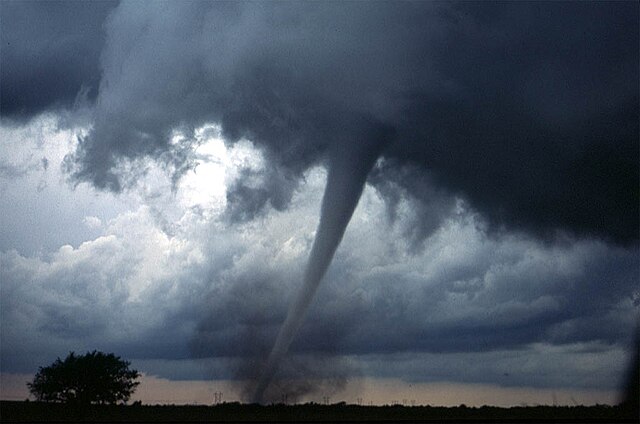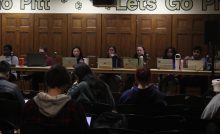Warmer atmospheric conditions contribute to increased tornadoes in Pittsburgh area


This spring, the National Weather Service’s Pittsburgh office recorded a total of 14 tornadoes in its coverage area, which includes nearby areas of West Virginia and Ohio. The Pittsburgh region typically averages about six tornadoes a year, meaning that this number has already been doubled before peak tornado season in June. Since the start of May, nine tornadoes have occurred in the Pittsburgh region alone, the highest number recorded since 1985.
Josef Werne, a professor in the department of geology and environmental science at Pitt, said energy in the form of warm, moist air from the Gulf of Mexico and wind shear, or the changes in wind speed and direction between the ground and upper atmosphere, are the two major factors that predict tornado generation.
“Increasing global temperatures will generally increase energy, but decrease wind shear since it influences the position and strength of the jet stream, so it is not totally clear what will happen,” Werne said. “Climate modeling suggests that the increase in energy from warming is playing a bigger role than changes in wind shear … indicating that we should expect a trend of increasing tornadoes, though this is not totally confirmed yet.”
Mark Abbott, a professor in the department of geology and environmental science at Pitt, said the energy produced by warmer conditions allows extreme weather patterns to manifest.
“You’re adding the effects of El Niño last year, which formed the atmosphere,” Abbott said. “[The increase in tornadoes is] largely due to the high sea surface temperatures, dropping [a lot] of evaporation off the oceans and the warmer atmosphere being able to hold more humidity. That just creates power for storms that have more unsettled atmospheric conditions and [makes] bigger storms more frequent.”
Michael Ramsey, a professor in the department of geology and environmental science at Pitt who teaches a class on natural disasters, said warmer air and water temperatures may have expedited the tornado season in northern states such as Pennsylvania, which reach warmer temperatures later than southern states.
“This is the prime season for tornadoes, and as spring gives way to summer, the highest risk for them moves from the southern states like [Alabama] and [Mississippi] northward through ‘tornado alley’ until states in the upper Midwest are most at risk in June and July,” Ramsey said. “Storms are more intense with warmer air and water temperatures, [which is] why the tornado high-risk zone moves northward with the season. This year has seen a very warm winter and spring, [and] the water temperatures in the Gulf of Mexico are also warmer, all [of which] leads to more tornadoes.”
In addition to warming atmospheric conditions, another potential contributor to increased tornadoes in Pittsburgh is the “eastward slide of tornado alley,” with the majority of large tornado outbreaks shifting toward the Mississippi River Valley area rather than the Plains region of the United States.
“Although [Pennsylvania] and Pittsburgh aren’t at high risk in the new map, there is a slight uptick in frequency, which seems to have been even stronger this season,” Ramsey said.
Ramsey said while it is difficult to attribute increased natural disasters to climate change directly, continuing warm conditions will likely contribute to increased storms.
“In general, warmer air and water are the energy for these storms, [and] there’s a predicted higher than average hurricane season this year because of that,” Ramsey said. “So, as the climate warms, more severe storms, [as well as] alternating periods of prolonged dry spells, will become more the norm.”
According to Ramsey, to stay informed about inclement weather, Pittsburgh residents should “keep aware” of warnings and watches issued by the weather service and local news reports. He said a tornado warning will also result in a push notification to all cell phones in the area, and that residents should “always opt-in to [these] emergency services.”
Ramsey said the first step in preparing for a tornado is to be aware of its risk level given one’s location.
“Tornadoes generally move in a northeasterly to easterly direction,” Ramsey said. “If you know where the tornado has touched down and your town is south or west of there, the risks are much lower for you. If you’re east [or] northeast, then there is a much higher chance that the tornado is moving your way.”
Ramsey said that, in the event of a tornado, residents should protect themselves by moving to the “centermost part” of their house or apartment away from windows and have a weather radio or a fully charged cell phone on hand to listen for news or updates.
“Basements are best, and typically, bathroom walls are stronger,” Ramsey said. “Try to cover yourself with a mattress or pillows to protect from falling debris.”
Werne said that if one is not indoors when a tornado occurs, one should shelter in place at a low altitude.
“Don’t expect to be able to outrun [a tornado],” Werne said. “If you’re outside, get to a low point like a ditch if you can.”
Historically, 98% of tornadoes in the Pittsburgh region have been EF0s or EF1s on the Enhanced Fujita Scale based on estimated wind speeds and related damage. Of the tornadoes recorded in Pittsburgh this month, three were ranked as EF2s, with wind gusts ranging from 111 to 135 mph, according to a recent article by CBS News.
Ramsey said although tornadoes have been more frequent in Pittsburgh this spring, most are unlikely to cause extreme harm to structures.
“The somewhat good news is that, even though Pittsburgh has had more tornadoes recently, they have been on the lower end of the severity scale,” Ramsey said. “It’s very unlikely that an EF0 or EF1 will do catastrophic damage to your house or neighborhood, but they can still be deadly if you are outside and in the wrong place at the wrong time.”
Recent Posts
SGB addresses concerns about ICE presence on campus, hears SJP lawsuit against administration, approves governing code bill
At its weekly meeting on Tuesday at Nordy’s Place, Student Government Board heard concerns about…
ACLU of Pennsylvania sues Pitt over SJP suspension
The ACLU of Pennsylvania filed a federal civil lawsuit against the University of Pittsburgh and…
Marquan Pope: The ultimate shark
One of the most remarkable things about sharks is that an injury doesn’t deter them.…
Who Asked? // Do we really get a summer vacation?
This installment of Who Asked? by staff writer Brynn Murawski mourns the seemingly impossible perfect…
Notes From an Average Girl // Notes from my junior year
In this edition of Notes From an Average Girl, senior staff writer Madeline Milchman reflects…
Meaning at the Movies // The Power of the Movie Theater
In this edition of “Meaning at the Movies,” staff writer Lauren Deaton discusses her love…

